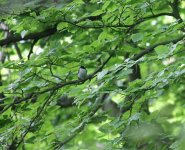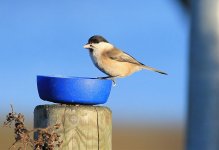Netherton reservoir & Saltwells Nature Reserve
Had a quick visit today after returning to the Midlands popped into my nieces house (about 10mins from the reservoir) It was a little bit overcast with a slight rain fall on Reservoir they had not too many species (checklist to follow at the bottom of this little ditty).
No one on the water so was hoping to see more but did see a Great crested grebe with 2 Juveniles one looked a lot bigger than the other, over the road there were quite a few smaller species in the tree’s and brambles these included Willow warbler, Chiffchaff, Blackcap and a very large flock of Long tailed tits. Back to the reservoir now I saw a Sparrowhawk fly low across the water which panicked all the birds on the water including 3 Swan cygnets (no adult birds anywhere to be seen).
Now onto Saltwell Nature Reserve it’s this place could be a golden gem with the dense tree’s and pen area’s along with a small stream following through and views above the tree line over the old pits. Some of the paths are a little steep and some of the gateways are a little small for the bigger person like myself, it’s very easy to get to by public transport just catch the number 81 (centro bus fare £2.00) bus from Merry hill bus station and get off just past the reservoir (this takes you to the top of the reserve) or you can catch either 217 (arriva), 276 (centro) or 297 (centro) all these will drop you off close to the bottom of the reserve by the Saltwells public house once of the bus just follow the signage to the entrance of the reserve.
There is also a car park by the public house you can use it’s literally next to the reserve, there are a choice of walks around the reserve please look at the notice board all are very interesting .
This place is well worth a visit and I think the more experienced Birder may find more species within this wonderful reserve
SPECIES SEEN TODAY
RESERVOIR –
Magpie, Woodpigeon, Lesser black backed gull (8 – 3 ad, 5 juv), Carrion crow, Black headed gull (12), Coot (22), Great crested grebe 3 (1ad 2 juv), 3 Swan (mute) cygnets, Mallard (15), Robin, Blackcap, Sparrowhawk & Herring gull (3)
HEDGE ROW OPPOSITE RESERVOIR (other side of the road) –
Long tailed tit (30+), Chiffchaff, Willow warbler, Blue tit, Blackcap, Woodpigeon, Jackdaw, Robin, Dunnock, Blackbird & Collared dove
SALTWELLS NATURE RESERVE –
Dunnock, Wren, Bullfinch, Song thrush, Robin, Woodpigeon, Carrion crow, Great tit, Jay, Great spotted woodpecker, Chaffinch, Chiffchaff, Starling, House sparrow, Blackcap, Magpie, Goldfinch, Pied wagtail, Blue tit, Kestrel & Buzzard








